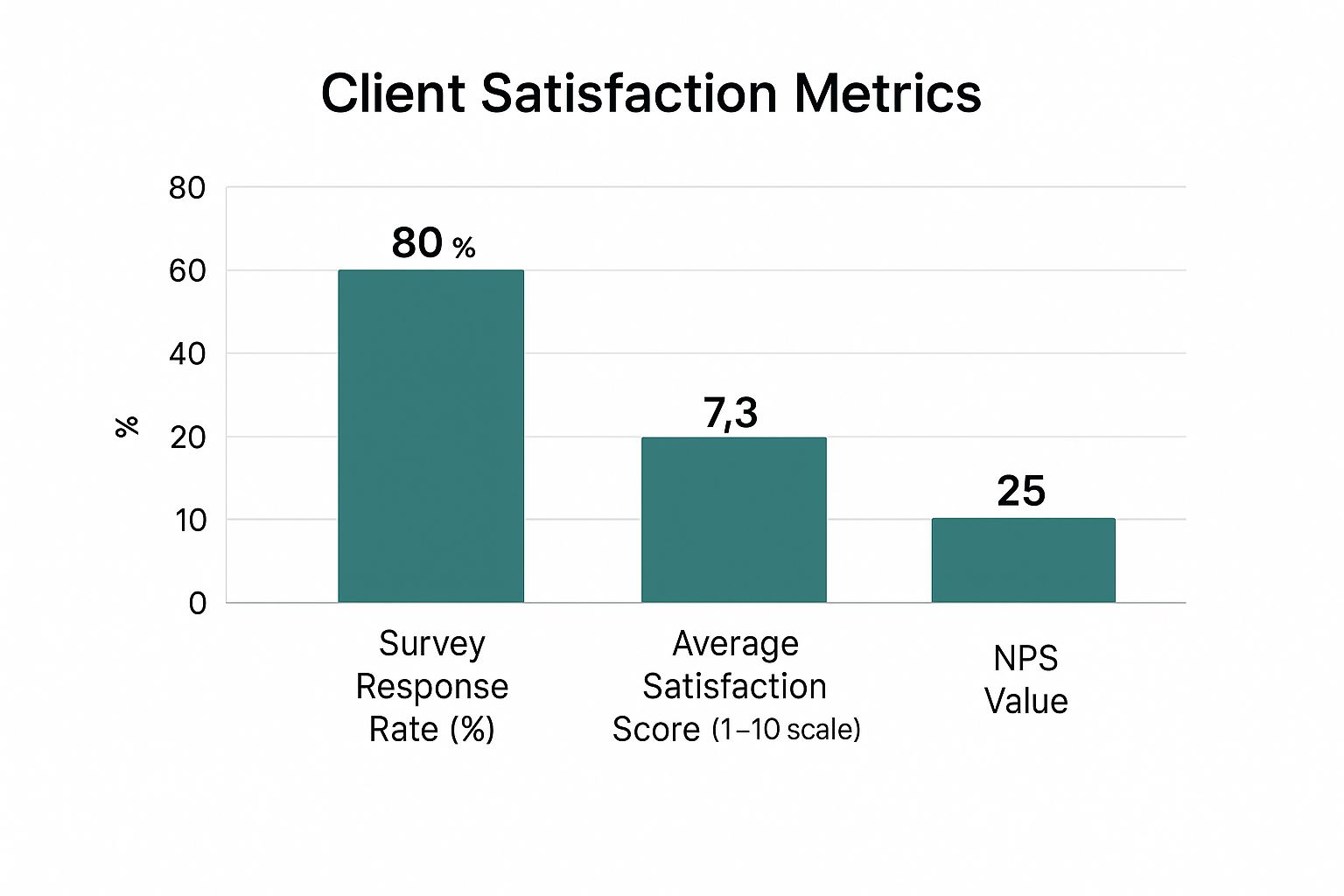Staring at a client list, wondering why last year’s “happy” clients have gone silent? This guide gives you a quick win: a simple method to uncover why clients really leave and a step-by-step plan to turn their feedback into your strongest asset for growth.
Why "Happy" Clients Still Walk Away
We've all been there. You deliver work that perfectly matches the brief, the client seems thrilled, and the invoice gets paid on time. But when their next project kicks off or the retainer is up for renewal? Crickets. This disconnect between what looks like satisfaction and what drives actual loyalty is where countless businesses leak revenue.
Here’s the hard truth: a satisfied client isn't automatically a loyal one. Satisfaction is often just a feeling about a single transaction. It’s temporary. Loyalty, on the other hand, is a much deeper commitment. It’s built on a foundation of trust, consistent value, and a real relationship.
The Gap Between Satisfaction and Loyalty
Relying on a casual, "Everything was great!" is like trying to navigate with a faulty compass. It might point you in a generally positive direction, but it won't warn you about the cliffs ahead. Your clients might be happy with the final logo you designed but were secretly pulling their hair out over your slow response times. Or maybe they loved the report you wrote but feel a competitor could do it faster.
This is the satisfaction-loyalty gap, and it's a massive blind spot. In fact, a global study from the Qualtrics XM Institute revealed a telling trend: while overall customer satisfaction is holding steady, key loyalty drivers like trust and the intent to repurchase are dropping. This proves that just keeping clients content isn't enough anymore. You can dig into the specifics in their full report on global satisfaction and loyalty.
To truly understand client satisfaction, you have to dig deeper than a simple thumbs-up. It demands a structured way to get feedback on the entire journey, not just the finished product. And that whole process really begins with managing client expectations from the moment you first engage with them.
Pro Tip: Run a "Ghosting" Analysis
For a quick, high-impact reality check, take a look at your last 3-5 clients who left without warning. Don't just write them off. Map out their entire history with you. Look for patterns.
Were there communication delays?
Did scope creep become an issue?
Were there any missed deadlines, even minor ones?
This kind of internal audit is brilliant because it often uncovers the exact process weaknesses that polite clients will never tell you about directly.
This guide will give you a framework to move beyond polite nods and get to the heart of what clients really think. You'll learn how to use metrics that signal true loyalty, design surveys that people actually fill out, and turn those insights into concrete actions that keep your best clients coming back.
Choosing the Right Metrics for Your Business
You know you need to measure client satisfaction, but the alphabet soup of acronyms—NPS, CSAT, CES—can be intimidating. The secret is to stop trying to track everything and start tracking the right things. This is your first actionable step: moving from vague guesswork to a clear, data-driven understanding of what your clients value.

A solid dashboard like this gives you a snapshot of your client health at a glance, combining metrics to show a healthy survey response rate, a strong average satisfaction score, and a positive NPS. It’s a powerful combination.
The Big Three Satisfaction Metrics
To build a measurement system that actually works, you have to get to know the three core metrics. More importantly, you need to understand when to deploy each one. They aren't interchangeable; each tells a different part of your client's story.
Step 1: Pick Your Metric(s)
Choose the right tool for the job. This table breaks down the "Big Three" to help you decide which aligns with your specific goals.
Metric | Core Question | What It Measures | Best Used For |
|---|---|---|---|
CSAT (Customer Satisfaction Score) | "How satisfied were you with [X interaction]?" | Immediate, in-the-moment satisfaction with a specific touchpoint. | Post-interaction feedback, like after a support ticket is closed, a project milestone is hit, or a training session concludes. |
NPS (Net Promoter Score) | "How likely are you to recommend us to a friend or colleague?" | Overall relationship health and long-term client loyalty. | Quarterly or bi-annual check-ins to gauge churn risk, identify brand advocates, and forecast organic growth. |
CES (Customer Effort Score) | "How easy was it to get your issue resolved?" | The ease of the client experience and the amount of friction in your processes. | Immediately after a client has had to accomplish a task, like onboarding, finding information, or getting a problem solved. |
As you can see, there’s a tool for every job. CSAT gives you a pulse check, NPS gives you the big-picture relationship status, and CES flags the frustrating roadblocks that cause clients to leave.
Tying Metrics to Your Business Goals
The metrics you pick have to connect directly to what you're trying to achieve as a business. Are you fighting churn? Hunting for more referrals? Or trying to tighten up your service delivery?
If your main goal is account growth and referrals, then NPS is your North Star. It's the most direct measure of a client's willingness to put their own reputation on the line to advocate for you.
On the other hand, if you’re trying to improve your project management process, then transactional CSAT and CES are your best friends. They deliver real-time feedback on your communication, speed, and efficiency at every stage. This proactive approach helps you manage client interactions more effectively—a core function of any good client relationship management system.
Designing Surveys People Actually Complete
You’ve defined the perfect metrics, but there’s a painful catch: the best data in the world is useless if your clients never actually respond. Getting actionable feedback depends entirely on creating a survey experience that respects your client's time.
Step 2: Craft a High-Response Survey
Crafting a feedback request that gets opened and, more importantly, completed requires you to think like a designer. Don't just throw questions on a page; guide your client through a seamless and painless experience.
Keep it Short: A client is far more likely to spend 90 seconds on a focused, three-question survey than to even start a sprawling twenty-question monster.
Use Neutral Language: Biased questions poison your data. Frame questions in a simple, clear, and natural way.
Poorly-Phrased Question (Biased) | Well-Phrased Question (Neutral) |
|---|---|
"How much did you love our award-winning design process?" | "How would you rate the clarity and efficiency of our design process?" |
"Don't you agree our team is incredibly responsive and helpful?" | "How would you describe your experience with our team's communication?" |
Design for Thumbs: A huge number of your clients will open your survey on their phones. If it’s not easy to read and tap through on a small screen, you’ve already lost them.
Step 3: Nail the Timing
Sending a survey at the wrong time is a surefire way to get ignored. The right moment really depends on what you're trying to measure.
Transactional Feedback (The Snapshot): Ask for feedback immediately after a key interaction, like when a project milestone is completed or a support ticket is closed. Perfect for CSAT or CES surveys.
Relationship Feedback (The Panorama): Ask for feedback at regular intervals to gauge the overall health of the relationship. For retainer clients, a quarterly check-in is great. For one-off projects, send it a week or two after final delivery. Ideal for NPS surveys.
Consistency is everything, and automation is your best friend here. For instance, you can set up a workflow that automatically sends a CSAT survey 24 hours after a project phase is marked "complete" in your system.

This screenshot from Growlio shows just how easy it is to build a simple rule that triggers a feedback request when a project status changes. You can ask at the perfect moment, every single time, without any manual effort.
By thoughtfully designing your surveys, you transform measuring client satisfaction from a stale, one-way process into a valuable, ongoing conversation.
Analyzing Feedback and Turning It Into Action
You’ve done the hard work of designing great surveys, and the responses are finally rolling in. Now you’re staring down a new challenge: a mountain of data. It's easy to get overwhelmed. The secret? A simple, two-step process to turn chaotic feedback into actionable intelligence.
Step 4: Analyze the Data
First, create a central hub for all your feedback—a spreadsheet, a project board, or a platform like Growlio that consolidates survey results, emails, and meeting notes.
Once it's all in one place, tackle it in two parts:
Analyze the Numbers (The "What"): Track your primary metrics (NPS, CSAT, CES) over time. Is your overall NPS score slowly trending down? Did CSAT scores for "Project Onboarding" dip last quarter? Visualizing this on a simple chart makes patterns jump off the page.
Analyze the Comments (The "Why"): This is where the gold is. A low score tells you something is wrong, but a comment like, "Your weekly reports are confusing" tells you exactly what to fix. Use thematic analysis: read every comment and assign tags like
communication,reporting, oronboarding. Tally up the tags to see which issues are most common.
Mini-Case Study: How Thematic Analysis Saved the Day
A growing SaaS company was stumped. Their overall NPS score was healthy, but their support team felt like they were constantly putting out fires. They decided to manually tag every open-ended survey comment from the previous quarter. A powerful theme quickly emerged:integration setup. Customers loved the core product, but they were deeply frustrated when trying to connect the software to their other tools. Armed with this insight, the product team created a new, in-depth video tutorial covering the entire integration process. The result? Support tickets related to setup dropped by 15% within a single month.
Step 5: Close the Loop
Measuring client satisfaction is pointless if you don't act on what you learn. "Closing the feedback loop" means making sure every piece of insight triggers a meaningful response.
Create an Action Plan: Sort feedback into two buckets: Individual Fixes (urgent, one-off problems requiring personal follow-up) and Strategic Improvements (recurring themes that need a process-level solution). Assign an owner and a deadline to each.
Communicate Back: This is the most critical step. Tell your clients what you did. A short email explaining how their suggestion led to a real improvement transforms them from a customer into a partner. This builds fierce loyalty.
Pro Tip: Use an "Actionable Insights" Dashboard
Don't let insights die in a spreadsheet. Create a simple, shared dashboard in your project management tool or a platform like Growlio. All you need are three columns: Insight, Action, and Status. When feedback comes in, add it to the Insight column, assign an Action, and move the Status from To-Do to Complete. This makes the whole process transparent and ensures nothing falls through the cracks.
This cycle of listening, analyzing, and acting is what truly embeds measuring client satisfaction into your company's DNA. It’s a continuous process that drives small improvements that lead to huge gains in loyalty and retention over time. It's also deeply connected to creating a great experience from the very beginning; you can dive deeper into this with our guide to client onboarding best practices.
Get Started Today

You now have a complete, step-by-step framework for measuring client satisfaction. You've learned how to choose the right metrics, design surveys people will actually complete, and turn that raw data into a concrete action plan for growth.
The insights you need to build a more loyal client base are waiting to be uncovered. Stop guessing what your clients are thinking and start building a business that listens, adapts, and grows.
The next step is to put this into practice. You can implement this entire feedback loop—from automated surveys to action plans—in one central place. Start a free Growlio account today and turn client feedback into your most powerful growth engine.
Answering Your Questions About Measuring Client Satisfaction
So, you've decided to start measuring client satisfaction. Great! But now you're probably swimming in a sea of questions. How often should you send a survey? Is there one magic metric that tells you everything? This kind of uncertainty is common and often leads to "analysis paralysis," where you end up doing nothing at all.
The best advice I can give is to just start. Seriously, start simple. You don't need a perfect, all-encompassing feedback system on day one. Pick one important moment in your client's journey—like after onboarding or project completion—and ask a single, straightforward question. This approach gets you valuable data right away without overwhelming your clients or your team.
How Often Should We Actually Survey Clients?
There’s no one-size-fits-all answer here; the right survey cadence really depends on how you work with your clients. The goal is to find that sweet spot between being consistent and just being annoying.
Here’s what I’ve seen work best for different business models:
Project-Based Work: The key here is to check in at natural break points. Send a quick pulse survey after a major project milestone is hit. Then, follow up with a more comprehensive survey once the entire project is wrapped up. This gives you feedback on both the journey and the destination.
Ongoing Retainers: For these long-term relationships, a quarterly check-in usually works wonders. Using a relationship metric like NPS is perfect for this. It’s frequent enough to spot any wobbles before they become major problems but spaced out enough that clients don't feel pestered.
Transactional Feedback: Think about specific, one-off interactions, like when a support ticket is closed or a training session ends. For these, you want to ask for feedback immediately while the experience is still fresh in their minds. The feedback you get will be much more specific and actionable.
What's the One Metric I Absolutely Have to Use?
Everyone's looking for that one silver-bullet metric, but the truth is, it doesn't exist. It’s all about using the right tool for the right job.
If you’re trying to gauge overall loyalty and get a sense of future growth potential, the Net Promoter Score (NPS) is your best bet. It cuts right to the chase by asking how likely a client is to recommend you, which is a powerful indicator of their long-term value.
But what if you just need to know how a specific interaction went, like a call with a project manager? That's where the Customer Satisfaction Score (CSAT) shines. The most effective strategies I've seen combine a primary loyalty metric like NPS for the big picture with more targeted, in-the-moment feedback from CSAT or CES.
What are some good tools to get started?
You can absolutely get the ball rolling on measuring client satisfaction without spending a penny. Tools like Google Forms or the free plans from services like SurveyMonkey are fantastic for creating and sending your first basic surveys.
But as you grow, you'll start to feel the limitations of these free tools. The real magic happens when you use a platform that doesn't just collect the data, but helps you analyze it, spot trends, automate your feedback requests, and manage the entire "closing the loop" process. This is where an integrated system like Growlio becomes a non-negotiable for turning client feedback into measurable business growth.
Ready to stop guessing what your clients are thinking and start building a fiercely loyal base? The insights you need are just waiting to be uncovered.
